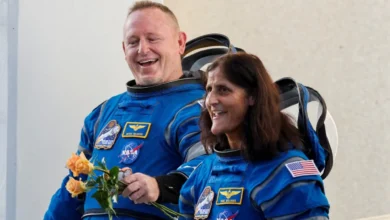Nasa Voyager 1: A Pioneering Journey Beyond the Solar System
Highlights in Short
- NASA Voyager 1 is a testament to human ingenuity and exploration.
- Voyager 1’s primary mission was to study the outer planets – Jupiter, Saturn, Uranus, and Neptune.
- As of April 2024, Voyager 1 is a staggering 162.7 AU (Astronomical Units) from Earth, making it the farthest human-made object. That’s roughly 15.1 billion miles!
NASA Voyager 1 is a testament to human ingenuity and exploration. Launched in 1977, it’s not just a spacecraft; it’s a fearless explorer venturing into the vast unknown – interstellar space. This article delves into the rich history of Voyager 1, its groundbreaking purpose, fascinating facts, and the recent events that saw NASA reconnect with its champion traveler after a suspenseful five months.
A Legacy Launched: The History of Nasa Voyager 1
In 1977, humanity embarked on a daring mission. As part of the Voyager program, Voyager 1 and its twin, Voyager 2, were launched to explore the outer reaches of our solar system. While Voyager 2 embarked on a grand tour of the gas giants, Voyager 1 took a faster, more direct route, becoming the first spacecraft to fly by Jupiter and Saturn, capturing breathtaking images that forever changed our understanding of these celestial giants.
A Daring Purpose: Unveiling the Solar System’s Secrets
Voyager 1’s primary mission was to study the outer planets – Jupiter, Saturn, Uranus, and Neptune. It aimed to unravel the mysteries of these distant worlds, their atmospheres, rings, and moons. Beyond the solar system, Voyager 1 carries the responsibility of venturing into interstellar space, a realm filled with unknowns. It acts as a scientific ambassador, carrying a Golden Record encoded with greetings, sounds, and images from Earth, a message in a bottle for any potential extraterrestrial civilizations.
Astounding Facts About Nasa Voyager 1
- Farthest Human-Made Object: As of April 2024, Nasa Voyager 1 is a staggering 162.7 AU (Astronomical Units) from Earth, making it the farthest human-made object. That’s roughly 15.1 billion miles!
- First Interstellar Traveler: In 2012, Nasa Voyager 1 crossed the heliopause, the boundary of the Sun’s influence, and entered interstellar space – the first human-made object to do so.
- Golden Record: The Golden Record onboard Nasa Voyager 1 carries greetings in 55 languages, a variety of music, and natural sounds like thunder and whale calls. It’s a snapshot of humanity for any potential alien recipients.
A Recent Hiccup and a Heartwarming Reconnection
In 2023, communication with Voyager 1 became erratic. For five long months, engineers at NASA were unable to receive the usual telemetry data. This silence sparked concerns about the spacecraft’s health. However, in April 2024, NASA jubilantly announced they had re-established communication with Voyager 1. The exact cause of the communication lapse remains under investigation, but the successful reconnection serves as a testament to the enduring resilience of this pioneering spacecraft.
The Future of Voyager 1: A Legacy That Continues
Voyager 1’s journey is far from over. It continues to transmit valuable scientific data about the interstellar medium, the space between stars. With its nuclear power source still functional, Voyager 1 is expected to keep sending transmissions for several more decades. It serves as a constant reminder of humanity’s capacity for exploration and serves as an inspiration for future generations to reach for the stars.
Explore More:


